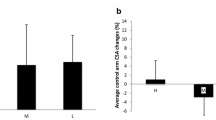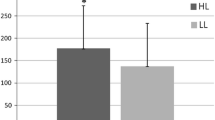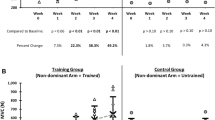Abstract
Maximal voluntary strength of simultaneous bilateral exertion has been shown to be small compared to the sum of the unilateral exertions. Three experiments were conducted to determine the effects of bilateral and unilateral resistance training on this bilateral deficit and to compare these in hands, arms, and legs. In each experiment, the subjects were divided into three groups: unilateral training group, bilateral training group, and control group. The subjects of the training group performed maximal isometric handgrip training in experiment I, and maximal isokinetic arm and leg extension training in experiments II and III. In each experiment, the subjects of the training group continued one of these resistance training exercises three times a week, for 6 weeks. The increase in handgrip strength of the bilateral training group produced in the bilateral condition [5.1 (SEM 2.4)%, after 3 weeks, 6.4 (SEM 2.3) %, after 6 weeks] was significantly greater compared with the control group [−1.1 (SEM 1.0) %, after 3 weeks, −1.5 (SEM 1.1) %, after 6 weeks. The increase in leg extension power of the bilateral training group produced in the bilateral condition [16.1 (SEM 9.6) %, after 3 weeks, 24.1 (SEM 7.4) %, after 6 weeks] was significantly greater compared with the unilateral training group [−5.0 (SEM 3.4) %, after 3 weeks, −3.4 (SEM 4.2) %, after 6 weeks] and the control group [−4.3 (SEM 2.5) %, after 3 weeks, 1.5 (SEM 5.5) %, after 6 weeks]. The increase in handgrip strength of the unilateral training group produced in the unilateral condition [7.3 (SEM 1.7) %, after 3 weeks] was significantly greater compared with the control group [−0.9 (SEM 1.8) %, after 3 weeks]. The increase in arm extension power of the unilateral training group produced in the unilateral condition [7.2 (SEM 1.8) %, after 6 weeks] was significantly greater compared with the bilateral training group [−3.0 (SEM 2.3) %, after 6 weeks] and the control group [−2.1 (SEM 2.6) %, after 6 weeks]. Bilateral indexes (BI) were shifted in a positive direction by bilateral training and tended to shift in a negative direction by unilateral training. With regard to the magnitude of change in BI, there were no significant differences among handgrip, arm extension, and leg extension training. It is suggested that there is lateral specificity in resistance training and that there is no difference among body parts in the modification of bilateral deficit by lateral training.
Similar content being viewed by others
Author information
Authors and Affiliations
Additional information
Accepted: 27 August 1996
Rights and permissions
About this article
Cite this article
Taniguchi, Y. Lateral specificity in resistance training: the effect of bilateral and unilateral training. Eur J Appl Physiol 75, 144–150 (1997). https://doi.org/10.1007/s004210050139
Issue Date:
DOI: https://doi.org/10.1007/s004210050139




